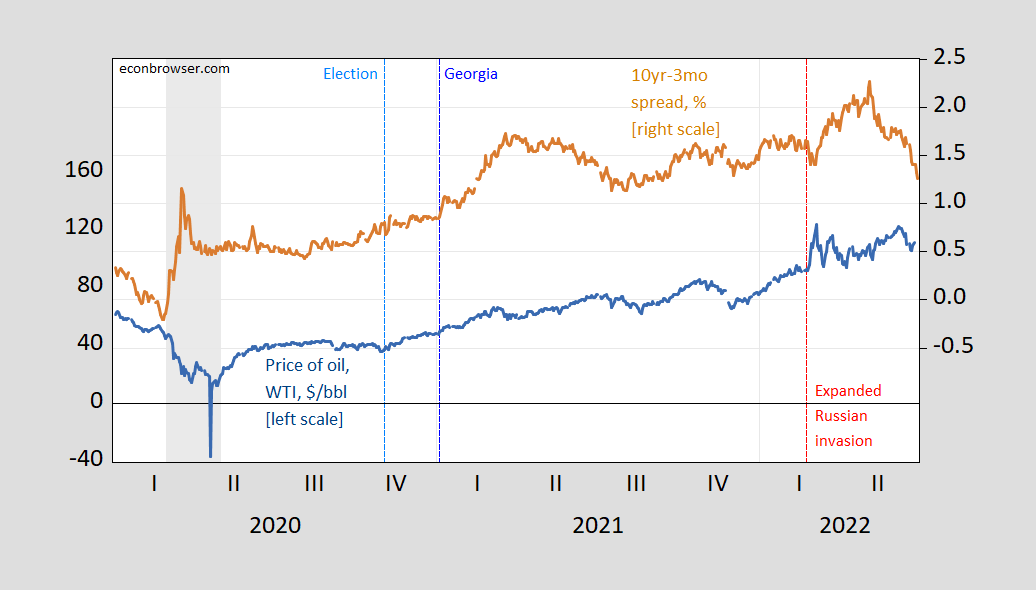Did Oil Prices Start Rising When Biden Started His War On Fossil Fuels
A reader writes:
I estimate (don’t kinda think) that a large portion of today’s inflation is due to environmental policies, in particular the war on fossil fuels.

Aside from provision of absolutely no documentation of the allegation, I note that oil prices started rising before Biden’s election. They did rise upon Biden’s election, although one should note that the 10yr-3mo Treasury spread also started rising, presumably not because of the war on fossil fuels, but rather because expectations of economic growth had risen. We can see the co-evolution of oil prices (which are determined in global markets) and the 10yr-3mo term spread in Figure 1.
Figure 1: Price of oil, WTI, $/bbl (blue, left scale), and 10yr-3mo Treasury spread, % (tan, right scale). NBER defined recession dates shaded gray. Sky blue dashed line at election, blue line at Georgia special election, and red dashed line at expanded Russian invasion of Ukraine. Oil price is FRED series DCOILWTICO, spread calculated using FRED series DGS10 and DGS3MO. Source: EIA, Treasury via FRED, NBER, and author’s calculations.
Oil prices actually started rising with the end of the recession, with the trough dated at April 2020.
The reader might also argue that the gyrations in oil prices since November 2020 have been due to an ongoing war on fossil fuels; I would tend to land on the side that macroeconomic fluctuations, supply decisions by the low-marginal cost producers (e.g., Saudi Arabia), and expectations drive the time variation in oil prices.
The argument that the war on fossil fuels drove inflation must mean that headline inflation across many countries has risen due to the US war on fossil fuels. Conceivable (kind of), but I must confess I don’t see the transmission mechanism.
Figure 2: Year-on-year CPI inflation for US (black), Euro area (HICP) (tan), UK (green), Canada (red), Australia (pink), in %. NBER defined peak-to-trough recession dates for US shaded gray. Source: BLS via FRED, European Commission via FRED, Canada via Statistics Canada, Australia via FRED/OECD MEI, NBER and author’s calculations.
More analysis from this particular reader, here. Since this reader does not believe in the usefulness of futures data, I have not included future data; the oil price data are spot. This reader has also accused me of hiding the raw data and mislabeling data; hence I have provided the FRED mnemonics for Figure 1. Links for the CPI data are available upon request.
More By This Author:
Recession Talk: U.S. and Euro Area
Of Revisions and Seasonality in the Pandemic Era
One Year Treasurys and One Year Forwards
Disclosure: None.






Since this is a "markets"site, we all know charts dont lie. Spread that daily chart of oil out, back to Election Day, and the picture becomes much more clearer. Oil was in a 36-42 dollar range for many months before Election Day. The chart clearly shows oil taking a downward leg from 42 in Oct 2020 to 35 the day before Election Day 2020. The election of Joe biden created a very profound and unmistakable V bottom, then skyrockets, almost doubling within 5 months. Biden guarenteed over and over again that he would "end the fossil fuel industry. His exact words. Since the US became the worlds largest producer of oil in Aug 2018 (thanks to Trumps pro energy policies), the US provided the worlds surplus, and has large influence over price, just like Saudi Arabia did when they were the largest producer. The oil market had to recalibrate future ecpectation of price when the US elected a new President that promised to reverse those pro energy policies. It is no coincidence that oil skyrockted upon Bidens election. Oil was trading in the high 90's before Putin invaded Ukraine. So yes, Biden is 100% at fault for high oil and gasoline prices. Charts dont lie.
Not sure I agree with all that you said. This oil expert offers some great insight: Robert Rapier on Talkmarkets.
He's no fan of Biden, but offers some exellent insight into the causes of oil pricing. And some of that is out of Biden's hands. Besides, high has prices is a global problem right now. It's not only in the US.